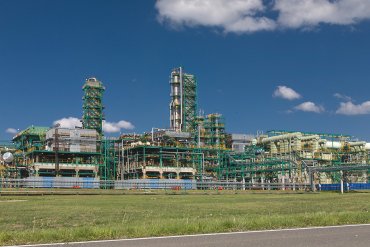ANTWERP, Belgium – Russian Group II and Group III base oil marketers are set to increase their exports in 2018, spurred by lower logistics costs and rising base oil prices, according to an industry insider.
Denis Varaksin, slack wax and base oil sales director for Berlin-based DYM Resources, said Russias total base oil export grew by 17 percent in 2017, compared to the year before, the largest such increase since 2011.

Photo courtesy of Slavneft
Pictured is the hydrocracker at Slavneft’s refinery in Yaroslavl, where its 100,000 t/y Group II and Group III base oil plant in Yaroslavl is expected to add 40,000 to 50,000 metric tons per year of Group III in 2018.
The central government is encouraging exports by reducing export duties on base stocks. The base oil export duty was equivalent to 40 percent of the crude oil export duty amount in 2016, Varaksin told ACIs European Base Oils and Lubricants conference held here in November. In 2017, that base oil export duty decreased to 30 percent. . This is accompanied by the lower logistics costs due to the ruble depreciation and rising base oil prices in 2016 and 2017.
DYM found that Russia exported 1.1 million metric tons of base oils in 2016, and it expects Group II and Group III base oil exports to account for 15 percent of the countrys total base oil exports in 2018.
The exports are expected to be stable and growing, while stable base oil prices stimulate production and export loadings, Varaksin said.
Slavnefts 100,000 t/y Group II and Group III base oil plant in Yaroslavl is expected to add 40,000 to 50,000 metric tons per year of Group III in 2018, according to DYM. Slavneft is a 50-50 joint venture between Rosneft and Gazprom Neft. The Group II and III capacity was added to the Yaroslavl plant in May.
DYM found that up to 5,400 tons of base oils were offered for export by Slavneft with loadings in December, he said. The Yaroslavl refinery is located close to Europe and the Baltic export gates. It can load trucks [that head] directly to the European Union, and thats the main strength of this refinery – Riga is 1,100 kilometers away.
The refinery offers 2 centiStoke, 4 cSt and 8 cSt products. He added that the refinery also exports around 40,000 t/y of Group I base oil.
Another plant expected to ramp up exports is Tanecos 190,000 t/y Group II and Group III base oil plant in Nizhnekamsk.
The plant produces 2.5 cSt Group II and 4 cSt Group III products, with plans to start 6 cSt in 2018. It started to stream in 2015, and the companys total exports in that year were 83,000 tons. In 2016 it exported 80,000 tons total.
While Tanecos location in Republic of Tatarstan is logistically not as favorable as Slavnefts, it has products registered with Europes Regulation on Registration, Evaluation, Authorization and Restriction of Chemicals (REACH) , and its Group III product is water white and of high quality, Varaksin added.
Another important factor that will drive the base oil production by these two companies is domestic demand for high quality base oils, which will increase after Frances Total opens its blending plant in Russia in 2018, according to DYM.
Other major foreign companies that run blending plants in Russia are the Anglo-Dutch Shell and the German Fuchs Oil.